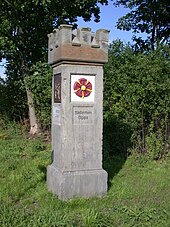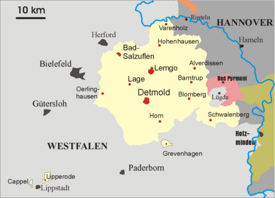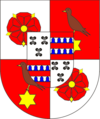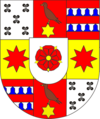Principality of Lippe
|
||||||||||||||||||||||||||||||||||||||||||||||||
The principality of Lippe was a German principality . It was created in 1789 when the county of Lippe was elevated to an imperial principality .
Initially, the Principality of Lippe was part of the Lower Rhine-Westphalian Empire in the Holy Roman Empire . It survived the end of the empire for a short time in the Rhine Confederation , continued in the 19th century in the German Confederation and in the German Empire and was converted into the Free State of Lippe in 1919 .
history

Leopold I (1767–1802) became the first Prince of Lippe in 1789. After Lippe joined the North German Confederation in 1866 and became part of the German Empire in 1871 , Prince Woldemar died childless on July 20, 1895. The title was then nominally transferred to his brother Alexander , who was unable to rule ; Prince Adolf zu Schaumburg-Lippe , who was appointed by Prince Woldemar in his will, first entered the reign .
Since the counts of Lippe-Biesterfeld and Lippe-Weißenfeld also made claims to regency and succession, the Lippe succession dispute that lasted until 1905 arose. The schaumburg-Lippe claim was actively supported by the German Kaiser Wilhelm II (whose sister Prince Adolf was married to).
However , an arbitration tribunal located at the Imperial Court in Leipzig decided the matter in 1897 in favor of Count Ernst zur Lippe-Biesterfeld , who then took over the regency. Nevertheless, on the instructions of Wilhelm II, he was denied the honors he was entitled to and the title "illustrious" by the military stationed in Lippe. Thereupon the paralyzed Grafregent wrote a circular to the German federal princes and complained about the emperor - an unprecedented event that strongly moved public opinion in Germany and took the position of Biesterfeld.
After the death of Count Ernst Ernst in 1904, his son Leopold took over the reign. When Prince Alexander died the following year and the Imperial Court finally recognized the right of succession of the House of Lippe-Biesterfeld, he ascended the throne as Prince Leopold IV .
After the First World War , on November 12, 1918, Prince Leopold IV abdicated. The Principality became a Free State , the Free State of Lippe , in the Union of the German Empire.
State structure and administrative structure
After the attempt to pass a constitution in 1819/20 had failed due to the estates, the first constitution was passed in 1836, which was liberalized in 1849 and initially restored in 1853, 1876 and 1912 and then continuously modernized. The electoral law introduced in 1876 replaced a constitution that had been largely based on estates for the longest time and introduced three-class voting rights - by no means an electoral law that offered citizens the possibility of general and equal democratic participation. Lippe was transformed into a constitutional monarchy . A state parliament was set up in 1836, which significantly embodied the legislative power within the framework granted by the sovereign. The highest state authority was the cabinet ministry, to which the higher administrative and judicial authorities were subordinate. The higher state administrative authority was the government college. In 1868 the princely and state possessions were separated. Prince remained an extensive Domanialvermögen (including the castles, domains, forests, long lease goods, the Bad Meinberg and Saline in Uflen ), which is largely the state after his abdication fell (see. Also domain question ).
For a long time the Prussian Higher Regional Court in Celle (State Treaty of January 4, 1879) acted as the higher regional court . The district courts of Alverdissen, Blomberg , Detmold , Hohenhausen, Horn, Lage, Lemgo , Oerlinghausen and Salzuflen were established in its judicial district of Detmold . The exclaves Lipperode and Cappel belonged to the Prussian district court of Lippstadt . Before Lippe joined the Higher Regional Court of Celle, it had been subordinate to the Higher Appeal Court in Wolfenbüttel since 1817, together with the Duchy of Braunschweig and the principalities of Schaumburg-Lippe and Waldeck . When this Wolfenbüttler court was dissolved, an interim Higher Appeal Court Commission was established to oversee the Lipper trials. As early as 1857, they joined the Hanover Higher Appeal Court of Celle , which was downgraded to the Prussian Appellate Court from 1866 as a result of the Prussian annexation of Hanover until it was converted into the Higher Regional Court in 1879, to which Lippe should belong until 1944.
In 1879 the five administrative offices of Blomberg , Brake , Detmold , Schötmar and Lipperode-Cappel were established in the principality . The cities of Barntrup, Blomberg, Detmold, Horn, Lage, Lemgo and Salzuflen as well as the Schwalenberg area remained vacant. In 1906 Schwalenberg was named a city .
In 1910, the Principality of Lippe was divided into eight cities with no offices and five administrative offices with thirteen offices:
- Official cities of Barntrup , Blomberg , Detmold , Horn , Lage , Lemgo , Salzuflen and Schwalenberg
- Administrative office Blomberg (offices Blomberg, Schieder and Schwalenberg) with 45 communities and an area of 199.36 km²
- Administrative office Brake (offices Brake, Hohenhausen, Sternberg-Barntrup and Varenholz) with 64 municipalities and an area of 364.60 km²
- Administrative office Detmold (offices Detmold, Horn and Lage) with 64 municipalities and an area of 375.05 km²
- Administrative office Lipperode-Cappel (Amt Lipperode-Cappel) with 3 municipalities and an area of 7.66 km²
- Administrative office Schötmar (offices Oerlinghausen and Schötmar) with 34 communities and an area of 158.06 km²
Princes
The Counts of Lippe came from the noble House of Lippe , whose first head was mentioned in 1123. Most of the princes came from the Lippe-Detmold line. After violent inheritance disputes, the reign was initially transferred to the Schaumburg-Lippe line (but the states of Schaumburg-Lippe and Lippe were only connected and not united), and finally to the Lippe-Biesterfeld line, which until then had no territory of its own. As early as 1720, the Roman-German Emperor intended to raise Count Simon Heinrich to the rank of imperial prince. However, the associated costs of 4400 Reichstalern could only in 1789 by a successor, Leopold I are applied. It was not until 69 years late that the House of Lippe-Detmold, part of the Westphalian imperial counties , was able to acquire the title of prince. The country became an imperial principality . However, the princes were also prevented from developing their power extensively due to the small size of the country and the resulting limited sovereignty, for example in military matters, especially due to the strong position of the estates.
A parliament was convened as early as 1836 and the power of the princes was restricted by a constitution. The last prince abdicated in the November Revolution of 1918, but was still allowed to live in Detmold Castle . The descendants of the last prince call themselves Prinzen zur Lippe. You still live in Detmold Castle today. The head of the family was Armin Prinz zur Lippe-Detmold from 1987 until his death in 2015 . His successor is his son, Stephan Prinz zur Lippe . The princes of Lippe were:
- December 16, 1789 to April 4, 1802:
Prince Leopold I (1767–1802) - April 4, 1802 to January 1, 1851:
Prince Leopold II (1796–1851)- April 4, 1802 to July 3, 1820:
Reign of Princess Pauline zur Lippe (1769–1820), widow of Prince Leopold I.
- April 4, 1802 to July 3, 1820:
- January 1, 1851 to December 8, 1875:
Prince Paul Friedrich Emil Leopold III. (1821-1875) - December 8, 1875 to March 20, 1895:
Prince Woldemar (1824–1895) - March 20, 1895 to January 13, 1905:
Prince Karl Alexander (1831–1905)- 1895–1897:
reign of Prince Adolf zu Schaumburg-Lippe (1859–1916) - 1897–1904:
reign of Count Ernst zur Lippe-Biesterfeld (1842–1904) - 1904–1905:
reign of Count Leopold zur Lippe-Biesterfeld (after Prince Leopold IV.)
- 1895–1897:
- October 25, 1905 to November 12, 1918:
Prince Leopold IV. (1871–1949)
State Ministry
The highest state authority was the State Ministry, to which the higher administrative and judicial authorities were subordinate. The higher state administrative authority was the government college.
| Term of office | Minister of State |
|---|---|
| 1810-1828 | Karl Friedrich Funk von Senftenau |
| 1829-1832 | Friedrich Wilhelm Helwing |
| 1832-1848 | Wilhelm Arnold Eschenburg |
| 1848-1850 | Friedrich Simon Leopold Petri |
| 1850-1853 | Christian Theodor von Meien |
| 1853-1855 | Laurenz Hannibal Fischer |
| 1856-1868 | Alexander von Oheimb |
| 1868-1872 | Carl Theodor Heldman |
| 1872-1875 | Adalbert von Flottwell |
| 1876-1885 | August Eschenburg |
| 1885-1889 | Hugo Samuel von Richthofen |
| 1889-1895 | Friedrich Otto Hermann von Wolffgramm |
| 1895-1897 | Karl Friedrich von Oertzen |
| 1897-1899 | Karl Gustav Oskar Miesitscheck von Wischkau |
| 1900-1912 | Max von Gevekot |
| 1913-1918 | Karl Ludwig von Biedenweg |
Representation in the Federal Council
In the Federal Council of the German Reich possessed lip one vote. The representative was chosen by the sovereign. Due to the low weight of votes in the Federal Council, which was dominated by Prussia (17 representatives), Lippe was practically insignificant; Together with 16 other countries, it was part of the group of small states that were each represented with only one vote.
economy

In addition to a textile industry based on the cultivation of flax and its processing into linen , the principality had a famous meerschaum industry in Lemgo, a salt works in Salzuflen (1878: 24,800 quintals of table salt ) and a wood industry that still exists today with numerous sawmills, their Raw material came from the country's vast forests. As in neighboring Prussia, the cigar industry also acquired particular importance , which, like the textile industry at first , was organized in a partly proto- industrialist division of labor in the publishing system . There were also breweries (including Strate and Falkenkrug ), brickworks , a sugar factory in Lage and oil mills . The largest industrial company was probably the Hoffmann starch factory .
The construction of the Lippische Bahn (1880) and the Lippische Nebenbahn (1895) were important for the industry, both of which ensured the connection to the main lines of the Cologne-Minden Railway Company . The Lippe state baths in Bad Meinberg and Bad Salzuflen and the saltworks in Bad Salzuflen also gained economic importance . Overall, however, Lippe was always an agrarian state, which was one of the economically weaker countries of the empire. Industry only existed to a limited extent (for example in relation to the northern Ravensberger Land ) and, like the textile and wood industry, was based directly on the country's agricultural or forestry resources.
This was u. a. a consequence of the great influence of the class and the monarch's not very business-friendly attitude at the beginning of industrialization. His economic interests lay above all in securing his own economic power, which until recently resulted less from taxes than from the direct income of the princely domains, forests, salt pans and state baths. The Lippe migrant workers (see also Lippische Ziegler ) were a consequence of this economic weakness. The loess-covered ridge landscapes in the Werre and Begatal at least made adequate agriculture possible. In the less fertile sand landscape of Senne, on the other hand, intensive agriculture was hardly possible. The keeping of grazing animals and the breeding of dairymen horses at the princely hunting lodge Lopshorn gained importance here .
military
On May 5, 1807, a Lippe battalion was set up, which, with the involvement of a Schaumburg-Lippe company , formed the 2nd battalion of the 5th Infantry Regiment of the Princes' Division of the Rhine Confederation . In 1867 Lippe signed a military convention with Prussia and from then on belonged to the replacement district of the VII Army Corps , 13th Division, 26th Infantry Brigade . On May 27, 1867, the princes division was dissolved to integrate the Lipper into the Prussian army . The Lipper were mainly used for the Prussian 6th Westphalian Infantry Regiment No. 55 . The regimental staff and the 3rd battalion were last based in Detmold (1918). The Lipper uniform was French, white, blue, and red around 1815. This uniform was also depicted on the emergency money of the city of Detmold around 1920, and it is remembered through the design of the bottle of the Lipper Schütze spirit . From 1867 at the latest, the Lippers wore the usual Prussian uniform and were then only recognizable by the Lipper cockade in the national colors of yellow-red-yellow ( illustration ) on III./IR 55.
In the true sense of the word, Lippe no longer had its own military by 1867 at the latest, and even before that, it was barely able to set up an independently operating troop of regimental strength. A caricature of this military weakness is drawn by the song Lippe-Detmold, a beautiful city that developed into a kind of regional anthem for the Lipperland. A Lippian general sees himself no longer in a position to continue the campaign after losing a man. The emergency money already mentioned above is designed according to the textual template of the song. Lippe gained a certain importance less through its soldiers than with the construction of the Senne military training area .
See also: Lippe Military Merit Medal , lippisches War Merit Cross , War Very Cross for heroic deed
currency
→ Main article : Lippe coin history
In 1875 the mark, introduced throughout the empire, also became a means of payment in the principality. The front side, the obverse , could at the coins to 2, 3, 5, 10 and 20 marks are designed by the member states of the realm. During this time, coins of 2 marks (1906) and 3 marks (1913) were issued in Lippe; both show the portrait of the ruling Prince Leopold IV.
coat of arms
Orders and decorations
As a sovereign state, Lippe also awarded medals and decorations. Most of the orders and decorations date from the principality, but medals were still awarded in the republic. These were u. a .:
- Rescue medal for heroic saving of life or property
- Order for Art and Science
- Lippe House Order , joint house order of the House of Lippe for services to the Lippe or Schaumburg-Lippe Princely House
- Leopold Order for services to the state
- War Merit Cross for bravery in war
- War Cross of Honor for heroic deed for heroism in war
- Military Medal of Merit for members of the military
- War Medal of Honor for services to public welfare, especially in the care of wounded and sick warriors
- Bertha Order , Order of Merit for Women in four classes
population
The principality (1887: 1,215.20 km²) counted
- 1871: 111,135 inhabitants
- 1881: 112,452 inhabitants
- 1885: 123,212 inhabitants
- 1905: 145,610 inhabitants
- 1910: 150,937 inhabitants
For comparison: the current 1,246.29 km² area of North Rhine-Westphalia counts
- 2008: 355,178 inhabitants
literature
- Johannes Arndt : The Principality of Lippe in the age of the French Revolution, 1770-1820. Waxmann, Münster 1992, ISBN 3-89325-090-5 .
- Johannes Arndt, Peter Nitschke (eds.): Continuity and upheaval in Lippe - Social-political relationships between Enlightenment and Restoration 1750–1820 , Landesverband Lippe, Detmold 1994, ISBN 3-9802787-6-X .
- Erich Kittel: History of the state of Lippe. Home chronicles of the districts Detmold and Lippe (= home chronicles of the cities and districts of the federal territory . Volume 18 ). Archive for German home care, 1957, ZDB -ID 749758-1 .
- Wolfgang J. Neumann: The Lippe state. Where he came from - where he went . Neumann, Lemgo 2008, ISBN 978-3-9811814-7-0 .
- Conrad Bornhak: The succession to the throne in the Principality of Lippe, using archival materials. Fontane, Berlin 1895 ( digitized version ).
- Margarete Hamer, Princess of Lippe-Weißenfeld: 275 years of Lippe-Weißenfeld. Volume 1: Hike from the Lippe region to Lusatia. Based on family history sources. Sollermann, Leer / Ostfriesland 2009, ISBN 978-3-938897-30-0 , p. 360.
- Margarete Hamer-Princess of Lippe-Weißenfeld: 275 years of Lippe-Weißenfeld. Volume 2: Hike from Lipper Land via Niederlausitz to Oberlausitz. Based on family history sources. Oberlausitzer Verlag Nürnberger, Spitzkunnersdorf 2017, ISBN 978-3-936867-68-8 , p. 440.
Web links
- Digital collection of the Lippe State Library Detmold, subject area "Lippe"
- Map of the Principality of Lippe German Historical Museum
- Rose country. Journal of Lippe History
- Principality of Lippe (offices and municipalities) 1910
- The medals and decorations of the Principality of Lippe-Detmold on hausorden.de
Individual evidence
- ^ A b Michael Rademacher: German administrative history from the unification of the empire in 1871 to the reunification in 1990. land_lippe.html. (Online material for the dissertation, Osnabrück 2006).
- ↑ a b c Constitution of the Land of Lippe of December 21, 1920
- ^ Lippe succession dispute on Wikisource
- ↑ Minutes of the Lippe People's and Soldiers' Council of November 12, 1918.
- ↑ The Free State of Lippe at a glance
- ↑ a b Meyers Konversationslexikon. Publishing house of the Bibliographisches Institut, Leipzig / Vienna, 4th edition, 1885–1892.
- ↑ Andreas Kunz (ed.): Lippe Detmold . (PDF; 37 kB) In: eKompendium-hgisg.de
- ↑ 1807–1815 The Napoleonic Wars woiste.de
- ^ The coins in the Principality of Lippe on woiste.de
Coordinates: 51 ° 56 '9.9 " N , 8 ° 52' 38.3" E














